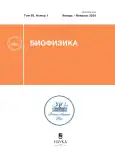Superoxide Generating Activity of Nicotinamide Coenzymes
- Авторлар: Sirota T.V1
-
Мекемелер:
- Institute of Theoretical and Experimental Biophysics, Russian Academy of Sciences
- Шығарылым: Том 69, № 1 (2024)
- Беттер: 24-31
- Бөлім: Molecular biophysics
- URL: https://journals.rcsi.science/0006-3029/article/view/257121
- DOI: https://doi.org/10.31857/S0006302924010032
- EDN: https://elibrary.ru/RIBSKI
- ID: 257121
Дәйексөз келтіру
Толық мәтін
Аннотация
Негізгі сөздер
Авторлар туралы
T. Sirota
Institute of Theoretical and Experimental Biophysics, Russian Academy of Sciences
Email: sirotatv@rambler.ru
Institutskaya ul. 3, Pushchino, Moscow Region, 142290, Russia
Әдебиет тізімі
- Сирота Т. В. Генерация супероксида никотинамидными коферментами. Biomed. Chem.: Research and Methods, 6 (1), e00188 (2023). doi: 10.18097/BMCRM00188
- Сирота Т. В. и Сирота Н. П. К механизму активации кислорода в химических и биологических системах. Биофизика, 67 (1), 5–13 (2022). doi: 10.31857/S000630292201001X
- Hayyan M., Hashim M. A., and Al Nashef I. M. Superoxide ion: generation and chemical implications. Chem.Rev., 116 (5), 3029–3085 (2016). doi: 10.1021/acs.chemrev.5b00407
- Andrés C. M. C., Pérez de la Lastra J. M., Andrés Juan C., Plou F. J., and Pérez-Lebeña E. Superoxide anion chemistry – its role at the core of the innate immunity. Int. J. Mol. Sci., 24 (3), 1841, (2023). doi: 10.3390/ijms24031841
- Ray P. D., Huang Bo-W., and Tsuji Y. Reactiv oxygen species (ROS) homeostasis and redox regulation in cellular signaling. Cell Signal., 24 (5), 981–990 (2012). doi: 10.1016/j.cellsig.2012.01.008
- Weihai Y. NAD+ and NADH in cellular functions and cell death, Front. Biosci., 11, 3129–3148 (2006). doi: 10.2741/2038
- Pollak N., Dölle C., and Ziegler M. The power to reduce: pyridine nucleotides-small molecules with a multitude of functions. Biochem. J., 402 (2), 205–218 (2007). doi: 10.1042/BJ20061638
- Мецлер Д. Биохимия: химические реакции в живой клетке (Мир, М., 1980), т. 2, сс. 250–253.
- http://vmede.org/sait/?page=15&id=Bioorganicheskaja_himija_tykavkina_2010&menu=Bioorganicheskaja_himija_tykavkina_2010
- Sirota T. V. A novel approach to study the reaction of adrenaline autooxidation: a possibility for polarographic determination of superoxide dismutase activity and antioxidant properties of various preparations. Biochemistry (Moscow). Suppl. Ser. B: Biomedical Chemistry, 5 (3), 253–259 (2011). doi: 10.1134/S1990750811030139
- Сирота Т. В. Использование нитросинего тетразолия в реакции автоокисления адреналина для определения активности супероксидисмутазы. Биомедицинская химия, 59 (4), 399–410 (2013). doi: 10.18097/pbmc20135904399
- Сирота Т. В. Цепная реакция автоокисления адреналина – модель хиноидного окисления катехоламинов. Биофизика, 65 (4), 646–655 (2020). doi: 10.31857/S0006302920040031
- Misra H. P. and Fridovich I. J. The role of superoxide anion in the autoxidation of epinephrine and a simple assay for superoxide dismutase. J. Biol. Chem., 247 (10), 3170–3175 (1972).
- Altman F. P. Tetrazolium saits and formazans. Progr. Histochem. Cytochem., 9 (3), 1–56 (1976). doi: 10.1016/S0079-6336(76)80015-0
- Guilbertt C. C. and Johnson S. L. Isolation and characterization of the fluorescent alkali product from diphosphopyridine nucleotide. Biochemistry, 10 (12), 2313–2316 (1971). doi: 10.1021/bi00788a021
- Valko M., Leibfritz D., Moncol J., Cronin M.T.D., Mazur M., and Telser J. Free radicals and antioxidants in normal physiological functions and human disease. Int. J. Biochem. Cell Biol., 39 (1), 44–84 (2007). doi: 10.1016/j.biocel.2006.07.001
Қосымша файлдар









